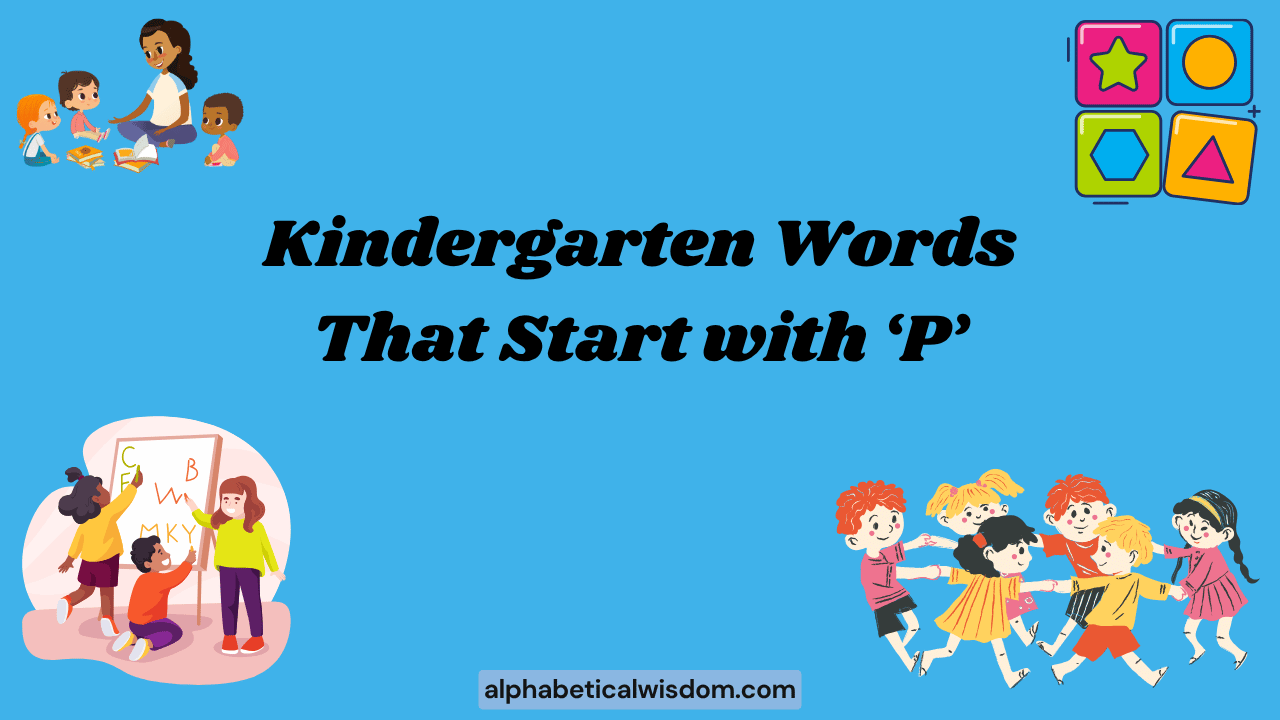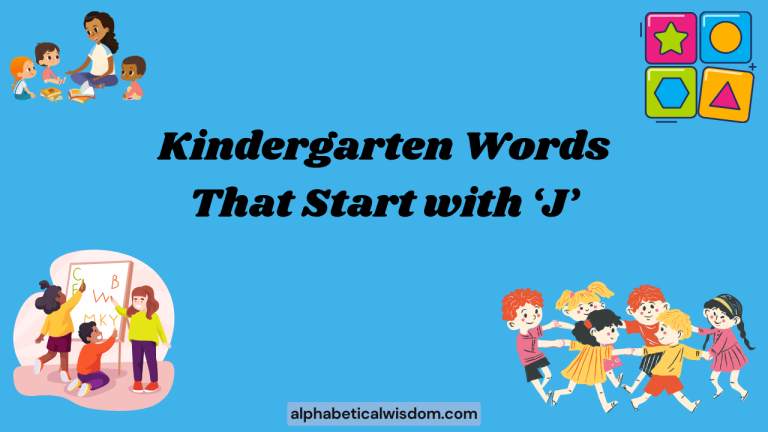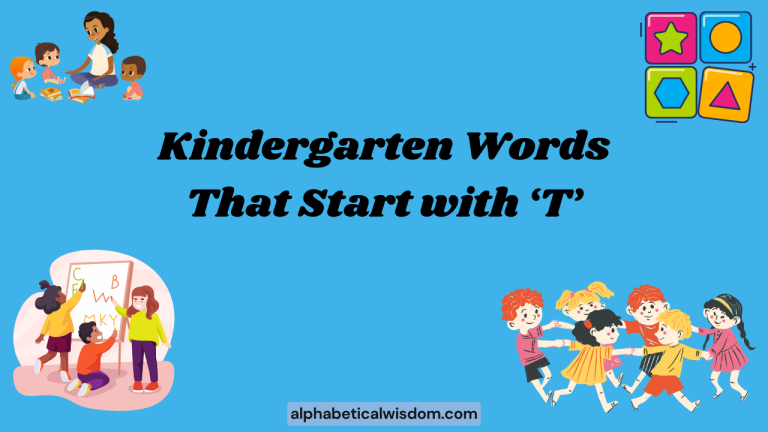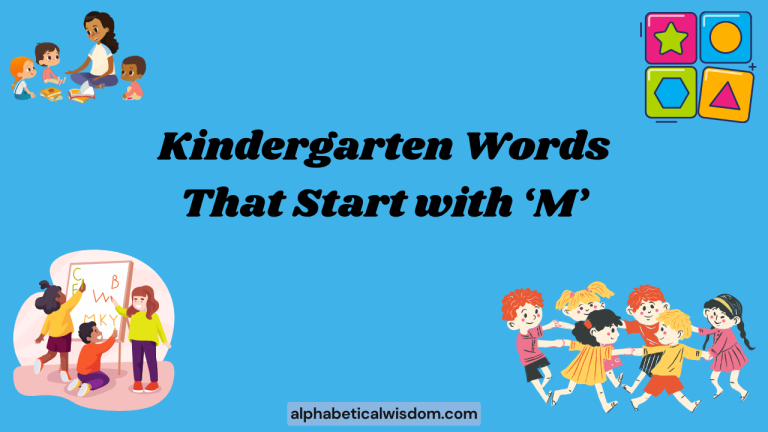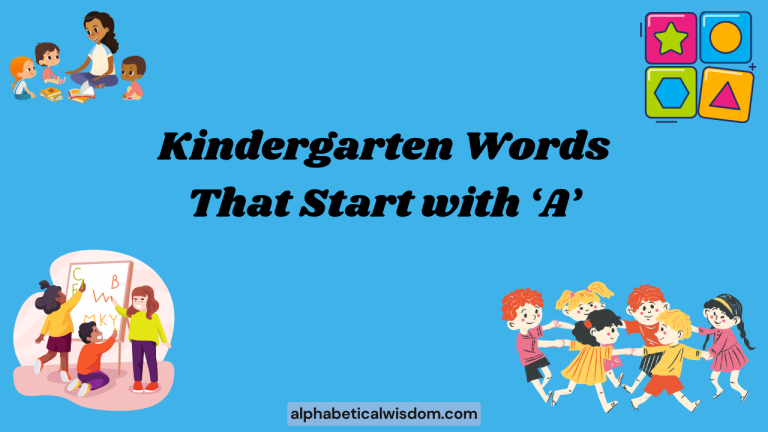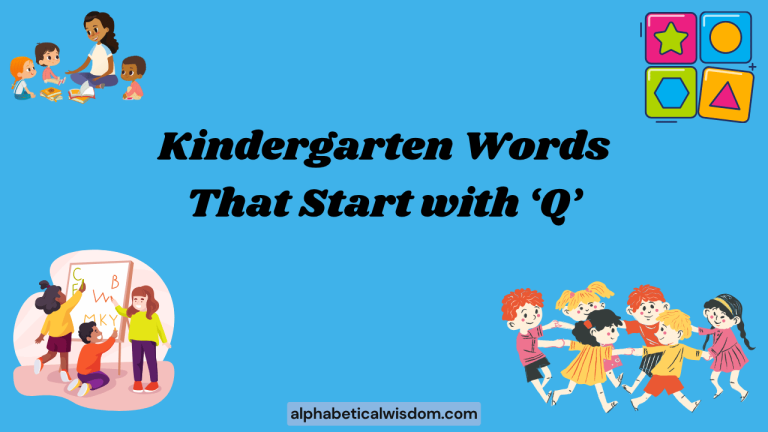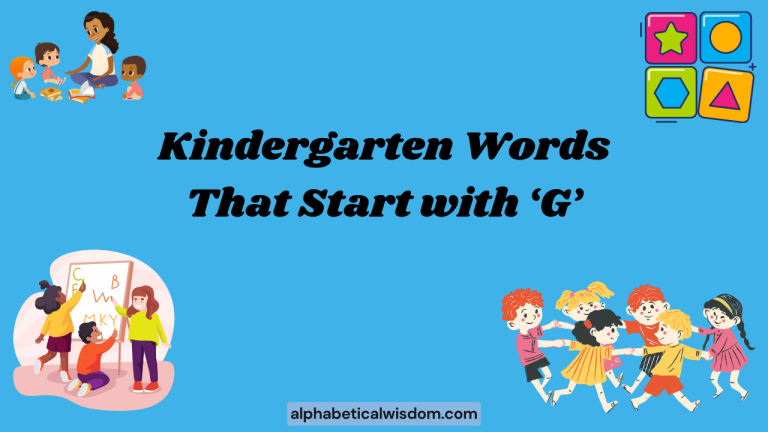Kindergarten Words That Start With P: A Comprehensive Guide
Learning new words is a crucial part of a child’s development, especially in kindergarten. Understanding words that start with the letter ‘P’ is essential for building vocabulary, improving reading skills, and enhancing communication.
This article provides a comprehensive guide to ‘P’ words suitable for kindergarteners, offering definitions, examples, usage rules, and practice exercises. This article is designed for parents, teachers, and anyone involved in early childhood education, providing a structured approach to help young learners master these foundational words.
Table of Contents
- Introduction
- Definition of Kindergarten Words Starting with ‘P’
- Structural Breakdown of ‘P’ Words
- Types and Categories of ‘P’ Words
- Examples of Kindergarten ‘P’ Words
- Usage Rules for ‘P’ Words
- Common Mistakes When Using ‘P’ Words
- Practice Exercises
- Advanced Topics
- FAQ
- Conclusion
Definition of Kindergarten Words Starting with ‘P’
Kindergarten words that start with the letter ‘P’ are words that are commonly used and understood by children in the kindergarten age group (typically 5-6 years old). These words are selected for their simplicity, relevance to a child’s daily life, and phonetic accessibility.
They form a foundation for early literacy, helping children develop reading, writing, and communication skills.
These words can be classified into different parts of speech, including nouns (e.g., pig, park), verbs (e.g., play, paint), and adjectives (e.g., pretty, pink). Understanding these classifications helps children grasp the different roles words play in a sentence and improves their overall language comprehension.
The function of these words is primarily to enable basic communication and understanding. They allow children to express their needs, describe their environment, and engage in simple conversations.
Furthermore, learning these words encourages cognitive development by enhancing memory, association skills, and the ability to categorize information.
Structural Breakdown of ‘P’ Words
The structural breakdown of ‘P’ words for kindergarten involves understanding their phonetic structure and spelling patterns. Most ‘P’ words at this level are relatively simple, consisting of three to five letters.
They often follow basic phonetic rules, making them easier for children to decode.
Many ‘P’ words are CVC (consonant-vowel-consonant) words, such as pig, pen, and pop. These words are fundamental in early reading instruction. Other ‘P’ words may include consonant blends, like play or prince, which introduce slightly more complex phonetic structures.
Understanding the structural elements of ‘P’ words also involves recognizing common spelling patterns. For example, the ‘P’ sound is almost always represented by the letter ‘P’ at the beginning of the word.
There are few exceptions to this rule in basic kindergarten vocabulary, which simplifies the learning process.
Types and Categories of ‘P’ Words
Nouns
Nouns are words that represent people, places, things, or ideas. Kindergarten nouns starting with ‘P’ are often concrete objects or familiar concepts that children can easily relate to. Examples include pig, park, pen, pencil, present, and puzzle. These words help children identify and name objects in their environment.
Nouns can be further categorized into common nouns (general names, like park) and proper nouns (specific names, like Paris, though these are less common in early kindergarten). Understanding this distinction is a foundational step in grammar development.
Verbs
Verbs are words that describe actions or states of being. Kindergarten verbs starting with ‘P’ are typically action words that children can easily act out or understand through observation. Examples include play, paint, push, pat, and pour. These words help children describe what they are doing or what others are doing.
Verbs can also express different tenses, although in kindergarten, the focus is primarily on the present tense. For example, “I play” indicates an action happening now. The use of the present continuous tense (“I am playing“) may also be introduced to describe ongoing actions.
Adjectives
Adjectives are words that describe nouns, providing more information about their qualities or characteristics. Kindergarten adjectives starting with ‘P’ are often descriptive words that appeal to a child’s senses or emotions. Examples include pretty, pink, purple, polite, and proud. These words help children describe what things look like, feel like, or how someone is behaving.
Adjectives can be used to compare nouns, although comparative and superlative forms are typically introduced later in elementary school. For example, “This flower is pretty” simply describes the flower, while “This flower is prettier” compares it to another flower.
Examples of Kindergarten ‘P’ Words
Nouns Examples
The following table provides a list of kindergarten nouns that start with the letter ‘P’, along with example sentences to illustrate their usage. These examples are designed to be simple and easy for young children to understand.
| Noun | Example Sentence |
|---|---|
| Pig | The pig lives on a farm. |
| Park | We go to the park to play. |
| Pen | I write with a pen. |
| Pencil | I draw with a pencil. |
| Present | I got a present for my birthday. |
| Puzzle | I like to solve the puzzle. |
| Plate | Put the food on the plate. |
| Plant | The plant needs water. |
| I have a toy in my pocket. | |
| Picture | I drew a picture of my family. |
| Pillow | I rest my head on the pillow. |
| Phone | My mom uses her phone. |
| Page | Turn the page to read more. |
| Pajamas | I wear pajamas to bed. |
| Party | We had a fun birthday party. |
| Pea | I ate a green pea. |
| Pear | I like to eat a sweet pear. |
| Pet | My pet dog is very friendly. |
| Pirate | The pirate sailed the seas. |
| Planet | Earth is our planet. |
| Pool | We swim in the pool. |
| Popcorn | We eat popcorn at the movies. |
| Postman | The postman delivers the mail. |
| Pot | We cook soup in a pot. |
| Puddle | I jumped in a puddle. |
Verbs Examples
The following table provides a list of kindergarten verbs that start with the letter ‘P’, along with example sentences to illustrate their usage. These examples are designed to be simple and relatable for young children.
| Verb | Example Sentence |
|---|---|
| Play | I like to play with my toys. |
| Paint | I paint a picture with watercolors. |
| Push | I push the swing at the park. |
| Pat | I pat the dog gently. |
| Pour | I pour juice into my cup. |
| Pick | I pick flowers in the garden. |
| Point | I point to the sky. |
| Pretend | I pretend to be a superhero. |
| Protect | I protect my toys from breaking. |
| Practice | I practice playing the piano. |
| Pack | I pack my backpack for school. |
| Plant | I plant seeds in the garden. |
| Praise | The teacher praised my good work. |
| Pray | We pray before dinner. |
| Prepare | We prepare food in the kitchen. |
| We print a picture from the computer. | |
| Promise | I promise to be good. |
| Pull | I pull the wagon. |
| Punch | I punch holes in paper with the hole punch. |
| Place | I place the book on the table. |
| Pass | I pass the ball to my friend. |
| Peel | I peel an orange. |
| Perform | I perform in the school play. |
| Plan | We plan a trip to the zoo. |
Adjectives Examples
The following table provides a list of kindergarten adjectives that start with the letter ‘P’, along with example sentences to illustrate their usage. These examples are designed to be descriptive and engaging for young children.
| Adjective | Example Sentence |
|---|---|
| Pretty | The flower is very pretty. |
| Pink | My dress is pink. |
| Purple | The grapes are purple. |
| Polite | It is polite to say “please” and “thank you.” |
| Proud | I am proud of my good grades. |
| Playful | The puppy is very playful. |
| Pleasant | The weather is pleasant today. |
| Popular | This is a popular toy. |
| Possible | It is possible to learn new things every day. |
| Proper | It is proper to use good manners. |
| Perfect | This is a perfect day for a picnic. |
| Pale | The color of the sky is pale blue. |
| Plain | This is a plain white wall. |
| Plastic | This is a plastic toy. |
| Pointed | The pencil has a pointed tip. |
| Poor | The poor man needed help. |
| Positive | It’s good to have a positive attitude. |
| Powerful | The superhero is very powerful. |
| Precise | The measurement has to be precise. |
| Pure | This is pure drinking water. |
Usage Rules for ‘P’ Words
Understanding the usage rules for ‘P’ words involves knowing how to correctly incorporate them into sentences. For nouns, this means using them as subjects, objects, or complements.
For verbs, it means using them to express actions or states of being, and ensuring they agree with the subject in number (singular or plural).
For example, when using the noun pig as a subject, the sentence structure might be: “The pig is eating.” When using the verb play, the sentence structure might be: “I play with my friends.” The adjective pretty can be used to describe a noun, such as: “The flower is pretty.”
It’s also important to teach children about articles (a, an, the) and how they are used with nouns. For example, “I see a pig” or “The park is fun.” Understanding these basic grammatical rules helps children construct meaningful and grammatically correct sentences.
Common Mistakes When Using ‘P’ Words
One common mistake is confusing words that sound similar but have different meanings, such as pair and pear. It’s important to provide clear examples and explanations to differentiate these words.
Another common mistake is misusing verbs, particularly with incorrect tense or subject-verb agreement. For example, a child might say “I paints” instead of “I paint.” Correcting these errors through repetition and practice is crucial.
Misspelling is also a frequent error, especially with words that have similar sounds but different letter combinations. For instance, a child might spell purple as “perple.” Regular spelling practice and visual aids can help minimize these mistakes.
| Incorrect | Correct | Explanation |
|---|---|---|
| I paints a picture. | I paint a picture. | Correct subject-verb agreement. |
| I want a pear of socks. | I want a pair of socks. | Distinguishing between pair and pear. |
| The flower is perple. | The flower is purple. | Correct spelling of purple. |
| I playd outside. | I played outside. | Correct past tense of play. |
| He pat the cat hardly. | He patted the cat gently. | Correct use of adverb and verb tense. |
Practice Exercises
Exercise 1: Fill in the Blanks
Complete the following sentences with the correct ‘P’ word from the word bank. This exercise helps reinforce vocabulary and sentence construction skills.
| Question | Answer |
|---|---|
| I like to ______ with my toys. (play, paint, push) | play |
| I use a ______ to write. (pen, pig, park) | pen |
| The flower is ______ in color. (pink, polite, proud) | pink |
| We go to the ______ to have fun. (park, pen, pig) | park |
| The ______ says thank you. (polite, purple, playful) | polite |
| I ______ a picture in class. (paint, pat, pour) | paint |
| The ______ lives on the farm. (pig, pen, park) | pig |
| I am ______ when I do well. (proud, pink, polite) | proud |
| I ______ the dog on the head. (pat, play, pour) | pat |
| The grapes are ______. (purple, pink, proud) | purple |
Exercise 2: Matching
Match the ‘P’ word with its definition. This exercise helps improve vocabulary and comprehension skills.
| Word | Definition | Answer |
|---|---|---|
| Park | A farm animal with a snout. | C |
| Pen | To make a picture using colors. | E |
| Pig | A place with slides and swings. | A |
| Paint | Being respectful and kind. | F |
| Play | To have fun and do activities. | B |
| Polite | A tool used for writing. | D |
Exercise 3: Sentence Building
Create a simple sentence using the given ‘P’ word. This exercise helps develop sentence construction and creative writing skills.
| Word | Example Sentence |
|---|---|
| Present | I received a nice present. |
| Pour | I pour water into the glass. |
| Push | I push the cart at the store. |
| Pretty | She has a pretty dress. |
| Puzzle | I like doing the puzzle. |
| Plant | I water the plant everyday. |
| Phone | I use my phone to call my mom. |
| Planet | Earth is our planet. |
| Pool | I go to the pool to learn swimming. |
| Popcorn | I love eating popcorn. |
Advanced Topics
For advanced learners, exploring more complex ‘P’ words and their nuances can be beneficial. This includes understanding words with multiple meanings (polysemy) and words with similar spellings but different pronunciations (homographs).
For instance, the word “present” can be a noun (a gift) or a verb (to introduce). These advanced concepts can deepen a child’s understanding and appreciation of the English language.
Additionally, introducing compound words that start with ‘P,’ such as “pancake” or “playground,” can expand vocabulary and improve reading comprehension. Discussing the etymology (origin) of certain ‘P’ words can also be an engaging way to enhance learning.
Exploring idioms and expressions that include ‘P’ words can add another layer of complexity and interest. For example, “piece of cake” (meaning something easy) or “put your best foot forward” (meaning to make a good impression) can be introduced to older kindergarteners who are ready for more challenging language concepts.
FAQ
- Why is it important for kindergarteners to learn words starting with ‘P’?
Learning ‘P’ words helps build a foundation for reading, writing, and communication skills. It expands their vocabulary and improves their ability to express themselves effectively.
- What are some easy ‘P’ words for kindergarteners to learn?
Easy ‘P’ words include pig, pen, park, play, paint, pink, and pretty. These words are simple, familiar, and easy to pronounce.
- How can I make learning ‘P’ words fun for my child?
Use games, flashcards, and interactive activities to make learning fun. Incorporate ‘P’ words into everyday conversations and read books that feature these words.
- What if my child struggles with pronouncing ‘P’ words?
Practice pronunciation through repetition and phonetic exercises. Break down the words into smaller sounds and encourage your child to imitate you.
- Are there any common mistakes to watch out for when teaching ‘P’ words?
Yes, watch out for confusion between similar-sounding words and misspellings. Provide clear examples and regular spelling practice to address these issues.
- How can I incorporate ‘P’ words into daily activities?
Use ‘P’ words when describing objects, actions, or feelings. For example, “Let’s go to the park to play” or “The flower is pretty and pink.”
- What are some good books for kindergarteners that feature ‘P’ words?
Look for books with simple language and engaging illustrations that incorporate ‘P’ words naturally into the story. Seek out books focused on phonics and early reading skills.
- How often should I practice ‘P’ words with my child?
Regular, short practice sessions are more effective than infrequent, long sessions. Aim for 10-15 minutes of practice each day to reinforce learning.
- How can I assess my child’s understanding of ‘P’ words?
Use simple quizzes, fill-in-the-blank exercises, and sentence-building activities to assess their understanding. Observe their ability to use ‘P’ words correctly in conversations.
- What other phonics concepts should my child learn alongside ‘P’ words?
Focus on basic phonetic sounds, consonant blends, and CVC words. Understanding these foundational concepts will support their overall literacy development.
Conclusion
Mastering kindergarten words that start with the letter ‘P’ is a significant step in a child’s literacy journey. This article has provided a comprehensive guide, covering definitions, structural breakdowns, examples, usage rules, common mistakes, and practice exercises.
By understanding these concepts and engaging in regular practice, children can build a strong foundation for reading, writing, and communication.
Remember to make learning fun and interactive, incorporating ‘P’ words into everyday activities and conversations. Encourage children to explore books, games, and other resources that feature these words.
With patience and consistent effort, young learners can confidently expand their vocabulary and develop a lifelong love of language.
